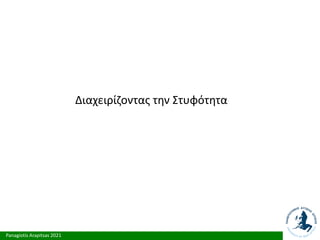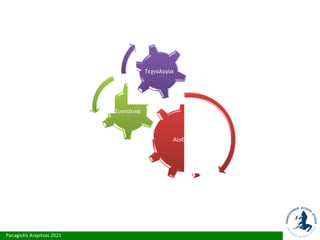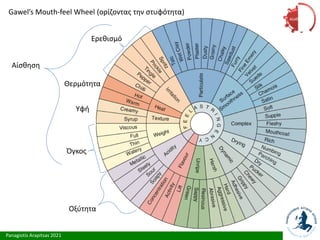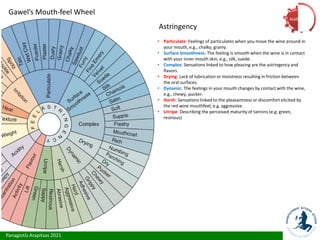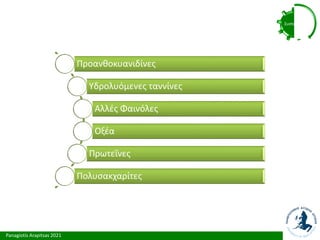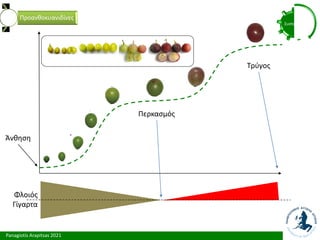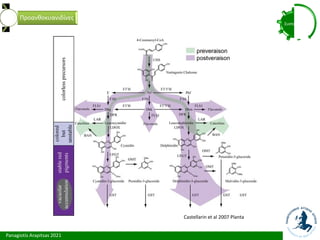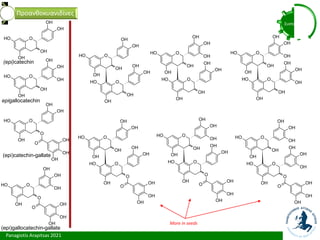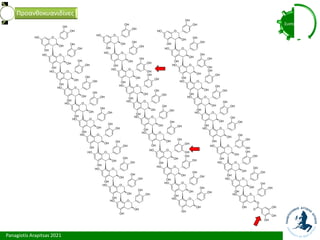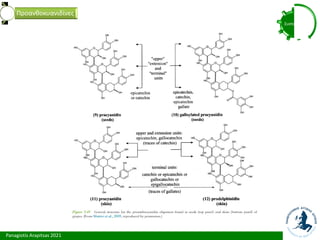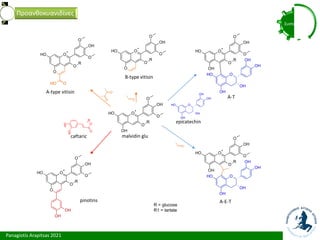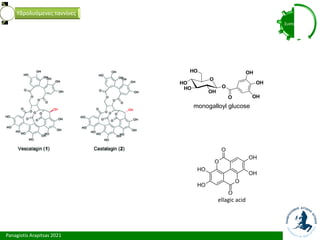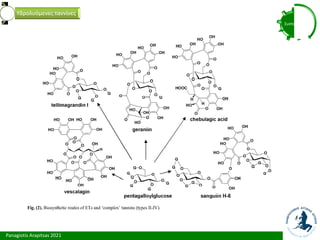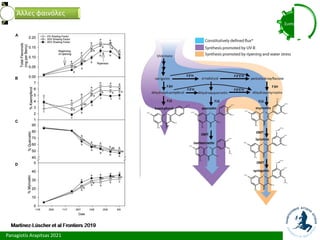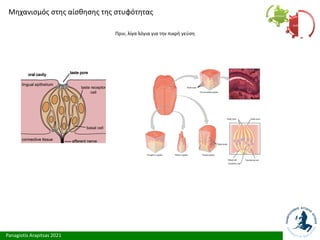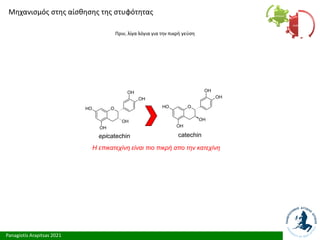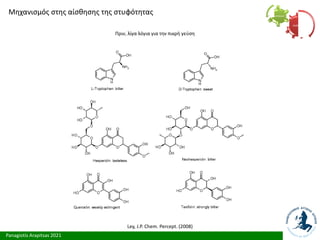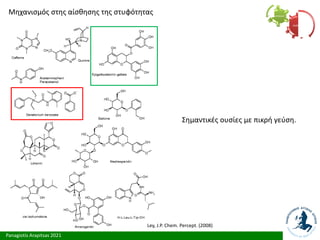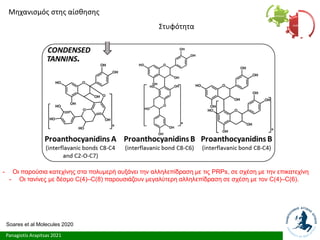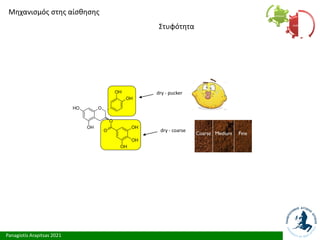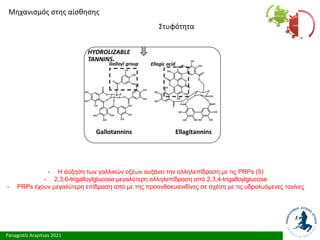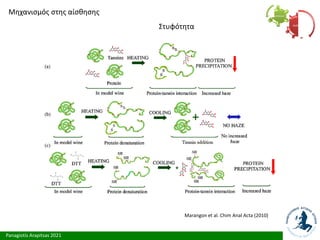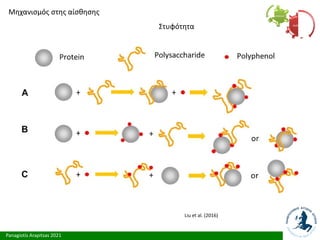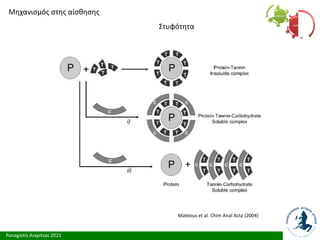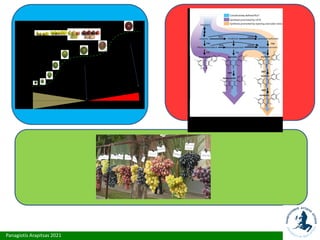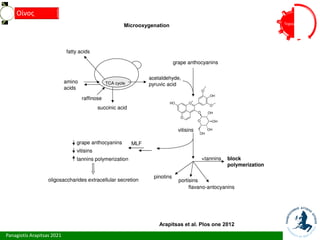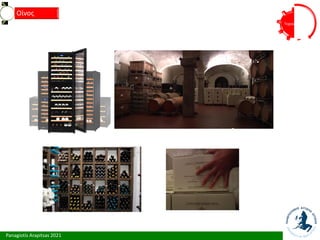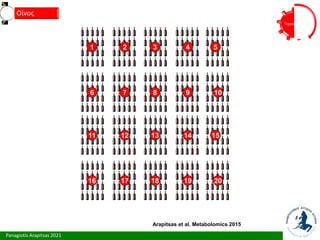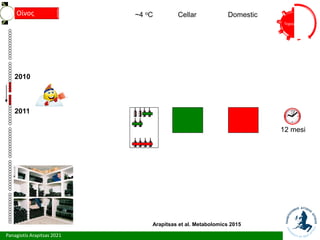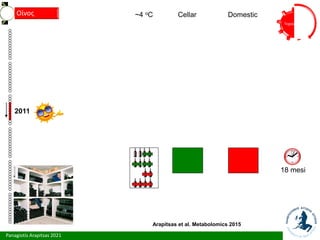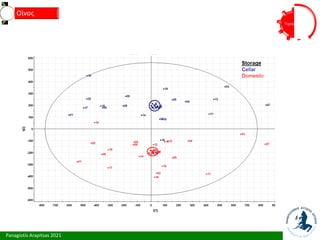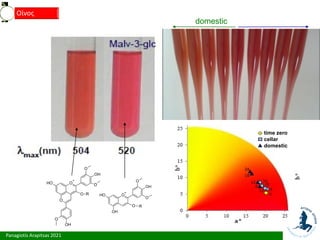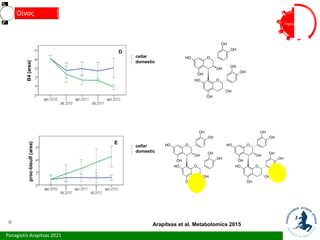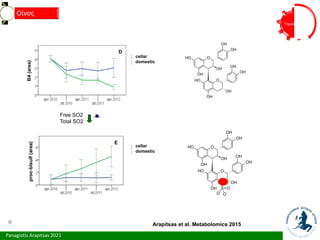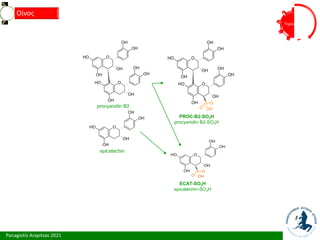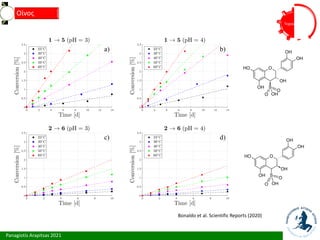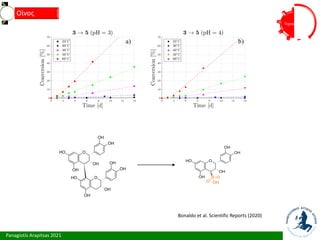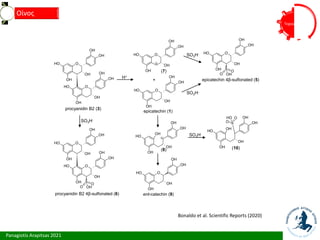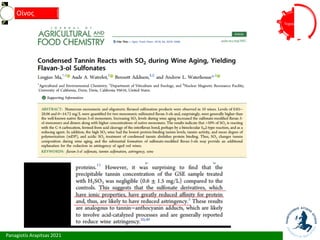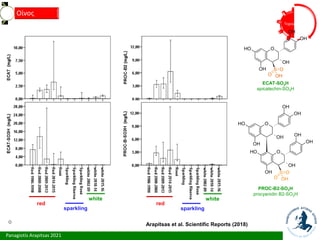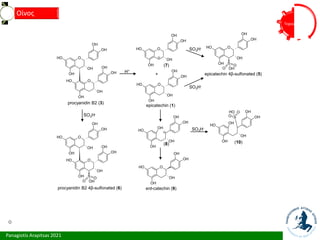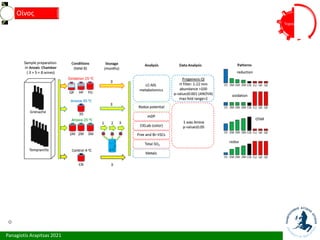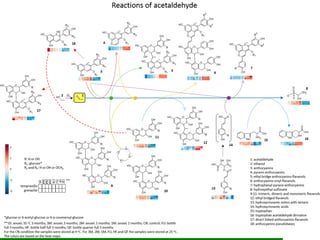Managing Astringency ΈîΈΙΈ±œ΅ΈΒΈΙœ¹Έ·ΈΕΈΩΈΫœ³Έ±œ² œ³ΈΖΈΫ ΈΘœ³œÖœÜœ¨œ³ΈΖœ³Έ±
- 1. Panagiotis Arapitsas 2021 ΈîΈΙΈ±œ΅ΈΒΈΙœ¹Έ·ΈΕΈΩΈΫœ³Έ±œ² œ³ΈΖΈΫ ΈΘœ³œÖœÜœ¨œ³ΈΖœ³Έ±
- 2. Panagiotis Arapitsas 2021 Panagiotis Arapitsas Oenology and Beverage Technology (TEI of Athens - Greece) Erasmus University of Turin, Italy Master in Methods of Synthesis in Organic Chemistry (University of Florence, Italy) PhD in Food Polyphenols Chemistry (University of Florence, Italy) Marie Curie βÄ™ University of Uppsala, Sweden Researcher at Fondazione E. Mach since 2010 Lecturer at University of Trento since 2019 Lecturer at University of Nova Gorica (Slovenia) since 2021 Lecturer at University of West Attika since 2016 panagiotis.arapitsas@fmach.it https://sites.google.com/a/fmach.it/wine-metabolomics/
- 4. Panagiotis Arapitsas 2021 Ann C NobleβÄôs Wine Aroma Wheel ΈëΈ·œÉΈΗΈΖœÉΈΖ
- 5. Panagiotis Arapitsas 2021 GawelβÄôs Mouth-feel Wheel (ΈΩœ¹Έ·ΈΕΈΩΈΫœ³Έ±œ² œ³ΈΖΈΫ œÉœ³œÖœÜœ¨œ³ΈΖœ³Έ±) Έ‰ΈΒœ¹ΈΦœ¨œ³ΈΖœ³Έ± ΈëΈ·œÉΈΗΈΖœÉΈΖ Έïœ¹ΈΒΈΗΈΙœÉΈΦœ¨ ΈΞœÜΈ° Έ¨Έ≥ΈΚΈΩœ² ΈüΈΨœçœ³ΈΖœ³Έ± ΈëΈ·œÉΈΗΈΖœÉΈΖ
- 6. Panagiotis Arapitsas 2021 GawelβÄôs Mouth-feel Wheel Astringency βÄΔ Particulate: Feelings of particulates when you move the wine around in your mouth, e.g., chalky, grainy. βÄΔ Surface Smoothness: The feeling is smooth when the wine is in contact with your inner mouth skin, e.g., silk, suede. βÄΔ Complex: Sensations linked to how pleasing are the astringency and flavors. βÄΔ Drying: Lack of lubrication or moistness resulting in friction between the oral surfaces. βÄΔ Dynamic: The feelings in your mouth changes by contact with the wine, e.g., chewy, pucker. βÄΔ Harsh: Sensations linked to the pleasantness or discomfort elicited by the red wine mouthfeel, e.g. aggressive. βÄΔ Unripe: Describing the perceived maturity of tannins (e.g. green, resinous) ΈëΈ·œÉΈΗΈΖœÉΈΖ
- 7. Panagiotis Arapitsas 2021 GawelβÄôs Mouth-feel Wheel Astringency βÄΔ Particulate: Feelings of particulates when you move the wine around in your mouth, e.g., chalky, grainy. βÄΔ Surface Smoothness: The feeling is smooth when the wine is in contact with your inner mouth skin, e.g., silk, suede. βÄΔ Complex: Sensations linked to how pleasing are the astringency and flavors. βÄΔ Drying: The inner mouth feels dry, not lubricated by lack of saliva in your mouth, e.g., parching. βÄΔ Dynamic: The feelings in your mouth changes by contact with the wine, e.g., chewy, pucker. βÄΔ Harsh: Sensations linked to the pleasantness or discomfort elicited by the red wine mouthfeel, e.g. aggressive. βÄΔ Unripe: Describing the perceived maturity of tannins (e.g. green, resinous) œ¨œ¹Έ±œÉΈΖ, œ¨œÉœÜœ¹ΈΖœÉΈΖ, Έ±ΈΚΈΩΈ°, Έ±œÜΈ° ΈΚΈ±ΈΙ Έ≥ΈΒœçœÉΈΖ ΈëΈ·œÉΈΗΈΖœÉΈΖ
- 8. Panagiotis Arapitsas 2021 GawelβÄôs Mouth-feel Wheel ΈïœÄΈΙœÜΈ±ΈΫΈΒΈΙΈ±ΈΚΈ° ΈΩΈΦΈ±ΈΜœ¨œ³ΈΖœ³Έ± œÉΈ±œ³Έ≠ΈΫ, ΈΦΈΩœÖœÉΈΚΈΒΈΦΈ≠ΈΫΈΩ Έ¥Έ≠œ¹ΈΦΈ±, ΈΦΈΒœ³Έ§ΈΨΈΙ Έ±œÄΈ±ΈΜœ¨ ΈΦΈΒœÉΈ±Έ·Έ± œ³œ¹Έ±œ΅œç ΈΚΈΩœ³ΈΜΈ≠, Έ≥œÖΈ±ΈΜœ¨œ΅Έ±œ¹œ³ΈΩ, œ΅Έ±ΈΜΈ· Έ≤ΈΒΈΜΈΩœçΈ¥ΈΩ, Έ¥Έ≠œ¹ΈΦΈ± œÉΈΩœÖΈ≠œ³, Έ≥ΈΩœçΈΫΈ± ΈëΈ·œÉΈΗΈΖœÉΈΖ
- 9. Panagiotis Arapitsas 2021 ΈΘœÖœÉœ³Έ±œ³ΈΙΈΚΈ§ Έ†œ¹ΈΩΈ±ΈΫΈΗΈΩΈΚœÖΈ±ΈΫΈΙΈ¥Έ·ΈΫΈΒœ² ΈΞΈ¥œ¹ΈΩΈΜœÖœ¨ΈΦΈΒΈΫΈΒœ² œ³Έ±ΈΫΈΫΈ·ΈΫΈΒœ² ΈëΈΜΈΜΈ≠œ² ΈΠΈ±ΈΙΈΫœ¨ΈΜΈΒœ² ΈüΈΨΈ≠Έ± Έ†œ¹œâœ³ΈΒΈêΈΫΈΒœ² Έ†ΈΩΈΜœÖœÉΈ±ΈΚœ΅Έ±œ¹Έ·œ³ΈΒœ²
- 11. Panagiotis Arapitsas 2021 ΈΘœÖœÉœ³Έ±œ³ΈΙΈΚΈ§ Έ†œ¹ΈΩΈ±ΈΫΈΗΈΩΈΚœÖΈ±ΈΫΈΙΈ¥Έ·ΈΫΈΒœ² Castellarin et al 2007 Planta
- 12. Panagiotis Arapitsas 2021 ΈΘœÖœÉœ³Έ±œ³ΈΙΈΚΈ§ Έ†œ¹ΈΩΈ±ΈΫΈΗΈΩΈΚœÖΈ±ΈΫΈΙΈ¥Έ·ΈΫΈΒœ² cyanidin delphinidin pelargonidin O O H OH OH OH OH O O H OH OH OH OH O O H OH OH OH OH OH O O H OH OH OH OH OH O O H OH OH OH O O H OH OH OH + + + epicatechin catechin epigallocatechin gallocatechin epiafzelechin afzelechin O O H OH O OH O OH OH OH OH O O H OH O OH O OH OH OH OH OH (epi)catechin-gallate (epi)gallocatechin-gallate
- 16. Panagiotis Arapitsas 2021 ΈΘœÖœÉœ³Έ±œ³ΈΙΈΚΈ§ Έ†œ¹ΈΩΈ±ΈΫΈΗΈΩΈΚœÖΈ±ΈΫΈΙΈ¥Έ·ΈΫΈΒœ² Έ™Έ·Έ≥Έ±œ¹œ³Έ± Έ†œ¹ΈΩΈΚœÖΈ±ΈΫΈΙΈ¥Έ·ΈΫΈΖ Έ€ΈΒ Έ≥Έ±ΈΜΈΜΈΙΈΚœ¨ ΈΩΈΨœç 4-10 mDP 75-90% (œÉœ³Έ±œÜœçΈΜΈΙ) ~ 60 % (ΈΩΈ·ΈΫΈΩœ²) ΈΠΈΜΈΩΈΙœ¨œ² Έ†œ¹ΈΩΈΚœÖΈ±ΈΫΈΙΈ¥Έ·ΈΫΈΒœ² Έ†œ¹ΈΩΈ¥ΈΒΈΜœÜΈΙΈΫΈΙΈ¥Έ·ΈΫΈΒœ² 20-80 mDP 10-25% (œÉœ³Έ±œÜœçΈΜΈΙ) ~ 40% (ΈΩΈ·ΈΫΈΩœ²)
- 17. Panagiotis Arapitsas 2021 ΈΘœÖœÉœ³Έ±œ³ΈΙΈΚΈ§ Έ†œ¹ΈΩΈ±ΈΫΈΗΈΩΈΚœÖΈ±ΈΫΈΙΈ¥Έ·ΈΫΈΒœ² epicatechin malvidin glu caftaric A-E-T A-T A-type vitisin B-type vitisin pinotins O + O O H OH O OH O R O + O O H O OH O R O OH OH O + O O H O OH O R O O + O O H O OH O R O O O H O O OH O H OH OH OH O + O O H OH O OH O R O OH O H OH OH OH O + O O H OH O OH O R O OH O H OH OH OH O O O OH OH O O R 1 R = glucose R1 = tartate
- 18. Panagiotis Arapitsas 2021 ΈΘœÖœÉœ³Έ±œ³ΈΙΈΚΈ§ ΈΞΈ¥œ¹ΈΩΈΜœÖœ¨ΈΦΈΒΈΫΈΒœ² œ³Έ±ΈΫΈΫΈ·ΈΫΈΒœ² O HO HO OH O HO O OH OH OH monogalloyl glucose O O O O O H O H OH OH ellagic acid
- 19. Panagiotis Arapitsas 2021 ΈΘœÖœÉœ³Έ±œ³ΈΙΈΚΈ§ ΈΞΈ¥œ¹ΈΩΈΜœÖœ¨ΈΦΈΒΈΫΈΒœ² œ³Έ±ΈΫΈΫΈ·ΈΫΈΒœ²
- 20. Panagiotis Arapitsas 2021 ΈΘœÖœÉœ³Έ±œ³ΈΙΈΚΈ§ ΈΞΈ¥œ¹ΈΩΈΜœÖœ¨ΈΦΈΒΈΫΈΒœ² œ³Έ±ΈΫΈΫΈ·ΈΫΈΒœ²
- 21. Panagiotis Arapitsas 2021 ΈΘœÖœÉœ³Έ±œ³ΈΙΈΚΈ§ ΈÜΈΜΈΜΈΒœ² œÜΈ±ΈΙΈΫœ¨ΈΜΈΒœ²
- 22. Panagiotis Arapitsas 2021 ΈΘœÖœÉœ³Έ±œ³ΈΙΈΚΈ§ ΈÜΈΜΈΜΈΒœ² œÜΈ±ΈΙΈΫœ¨ΈΜΈΒœ²
- 23. Panagiotis Arapitsas 2021 ΈΘœÖœÉœ³Έ±œ³ΈΙΈΚΈ§ ΈÜΈΜΈΜΈΒœ² œÜΈ±ΈΙΈΫœ¨ΈΜΈΒœ²
- 24. Panagiotis Arapitsas 2021 ΈΘœÖœÉœ³Έ±œ³ΈΙΈΚΈ§ ΈÜΈΜΈΜΈΒœ² œÜΈ±ΈΙΈΫœ¨ΈΜΈΒœ² O OH O H O OH O H OH O OH O H OH O H gallic acid p-OH-benzoic acid protocatechic acid coumaric acid coutaric acid fertaric acid caftaric acid caffeic acid ferulic acid coumaric acid ethyl ester caffeic acid ethyl ester gallic acid ethyl ester
- 25. Panagiotis Arapitsas 2021 ΈΘœÖœÉœ³Έ±œ³ΈΙΈΚΈ§ Έ†ΈΩΈΜœÖœÉΈ±ΈΚœ΅Έ±œ¹Έ·œ³ΈΒœ² MartΟ≠nez-Lapuente et al
- 26. Panagiotis Arapitsas 2021 Έ€ΈΖœ΅Έ±ΈΫΈΙœÉΈΦœ¨œ² œÉœ³ΈΖœ² Έ±Έ·œÉΈΗΈΖœÉΈΖœ² œ³ΈΖœ² œÉœ³œÖœÜœ¨œ³ΈΖœ³Έ±œ² Έ†œ¹ΈΙΈΫ, ΈΜΈ·Έ≥Έ± ΈΜœ¨Έ≥ΈΙΈ± Έ≥ΈΙΈ± œ³ΈΖΈΫ œÄΈΙΈΚœ¹Έ° Έ≥ΈΒœçœÉΈΖ ΈëΈ·œÉΈΗΈΖœÉΈΖ ΈΘœÖœÉœ³Έ±œ³ΈΙΈΚΈ§
- 27. Panagiotis Arapitsas 2021 Έ€ΈΖœ΅Έ±ΈΫΈΙœÉΈΦœ¨œ² œÉœ³ΈΖœ² Έ±Έ·œÉΈΗΈΖœÉΈΖœ² œ³ΈΖœ² œÉœ³œÖœÜœ¨œ³ΈΖœ³Έ±œ² Έ†œ¹ΈΙΈΫ, ΈΜΈ·Έ≥Έ± ΈΜœ¨Έ≥ΈΙΈ± Έ≥ΈΙΈ± œ³ΈΖΈΫ œÄΈΙΈΚœ¹Έ° Έ≥ΈΒœçœÉΈΖ ΈëΈ·œÉΈΗΈΖœÉΈΖ ΈΘœÖœÉœ³Έ±œ³ΈΙΈΚΈ§ O O H OH OH OH OH O O H OH OH OH OH epicatechin catechin Έ½ ΈΒœÄΈΙΈΚΈ±œ³ΈΒœ΅Έ·ΈΫΈΖ ΈΒΈ·ΈΫΈ±ΈΙ œÄΈΙΈΩ œÄΈΙΈΚœ¹Έ° Έ±œÄΈΩ œ³ΈΖΈΫ ΈΚΈ±œ³ΈΒœ΅Έ·ΈΫΈΖ
- 28. Panagiotis Arapitsas 2021 Έ€ΈΖœ΅Έ±ΈΫΈΙœÉΈΦœ¨œ² œÉœ³ΈΖœ² Έ±Έ·œÉΈΗΈΖœÉΈΖœ² œ³ΈΖœ² œÉœ³œÖœÜœ¨œ³ΈΖœ³Έ±œ² Έ†œ¹ΈΙΈΫ, ΈΜΈ·Έ≥Έ± ΈΜœ¨Έ≥ΈΙΈ± Έ≥ΈΙΈ± œ³ΈΖΈΫ œÄΈΙΈΚœ¹Έ° Έ≥ΈΒœçœÉΈΖ ΈëΈ·œÉΈΗΈΖœÉΈΖ ΈΘœÖœÉœ³Έ±œ³ΈΙΈΚΈ§ Ethyl bridged procyanidins ΈüΈΙ œÄœ¹ΈΩΈΚœÖΈ±ΈΫΈΙΈ¥Έ·ΈΫΈΒœ² ΈΦΈΒ ¬ΪΈ≥Έ≠œÜœÖœ¹Έ± Έ±ΈΙΈΗΈΙΈΜΈ·ΈΩœÖ¬Μ ΈΒΈ·ΈΫΈ±ΈΙ œÄΈΙΈΩ œÄΈΙΈΚœ¹Έ≠œ² Έ±œÄΈΩ œ³ΈΙœ² Έ±œÄΈΜΈ≠œ² œÄœ¹ΈΩΈΚœÖΈ±ΈΫΈΙΈ¥Έ·ΈΫΈΒœ² mDP ~ 3-5 O O H OH OH OH O O H OH OH OH OH OH R R O O H OH OH OH OH R O O H OH OH OH OH R direct linked procyanidins
- 29. Panagiotis Arapitsas 2021 Έ€ΈΖœ΅Έ±ΈΫΈΙœÉΈΦœ¨œ² œÉœ³ΈΖœ² Έ±Έ·œÉΈΗΈΖœÉΈΖœ² œ³ΈΖœ² œÉœ³œÖœÜœ¨œ³ΈΖœ³Έ±œ² Έ†œ¹ΈΙΈΫ, ΈΜΈ·Έ≥Έ± ΈΜœ¨Έ≥ΈΙΈ± Έ≥ΈΙΈ± œ³ΈΖΈΫ œÄΈΙΈΚœ¹Έ° Έ≥ΈΒœçœÉΈΖ ΈëΈ·œÉΈΗΈΖœÉΈΖ ΈΘœÖœÉœ³Έ±œ³ΈΙΈΚΈ§ ΈΦΈΩΈΫΈΩΈΦΈΒœ¹Έ° Έ¨œÉΈΩ Έ±œÖΈΨΈ§ΈΫΈΒœ³Έ±ΈΙ ΈΩ œÄΈΩΈΜœÖΈΦΈΒœ¹ΈΙœÉΈΦœ¨œ² ΈΦΈΒΈΙœéΈΫΈΒœ³Έ±ΈΙ ΈΖ œÄΈΙΈΚœ¹œ¨œ³ΈΖœ³Έ± O O H OH OH OH O O H OH OH OH OH OH R R O O H OH OH OH OH R O O H OH OH OH O O H OH OH OH OH OH R R O O H OH OH OH OH R Έ¥ΈΙΈΦΈΒœ¹Έ° œ³œ¹ΈΙΈΦΈΒœ¹Έ°
- 30. Panagiotis Arapitsas 2021 Έ€ΈΖœ΅Έ±ΈΫΈΙœÉΈΦœ¨œ² œÉœ³ΈΖœ² Έ±Έ·œÉΈΗΈΖœÉΈΖœ² œ³ΈΖœ² œÉœ³œÖœÜœ¨œ³ΈΖœ³Έ±œ² Έ†œ¹ΈΙΈΫ, ΈΜΈ·Έ≥Έ± ΈΜœ¨Έ≥ΈΙΈ± Έ≥ΈΙΈ± œ³ΈΖΈΫ œÄΈΙΈΚœ¹Έ° Έ≥ΈΒœçœÉΈΖ ΈëΈ·œÉΈΗΈΖœÉΈΖ ΈΘœÖœÉœ³Έ±œ³ΈΙΈΚΈ§ ΈüΈΙ Έ±ΈΙΈΗœÖΈΜΈΒœÉœ³Έ≠œ¹ΈΒœ² œ³œâΈΫ œÜΈ±ΈΙΈΫΈΩΈΜΈΙΈΚœéΈΫ ΈΩΈΨΈ≠œâΈΫ ΈΒΈ·ΈΫΈ±ΈΙ œÄΈΙΈΩ œÄΈΙΈΚœ¹ΈΩΈ· Έ±œÄΈΩ œ³Έ± Έ±ΈΫœ³Έ·œÉœ³ΈΩΈΙœ΅Έ± ΈΩΈΨΈ≠Έ± ΈΠΈ±ΈΙΈΫΈΩΈΜΈΙΈΚΈ§ ΈΩΈΨΈ≠Έ± O OH O H OH O H gallic acid coumaric acid caffeic acid coumaric acid ethyl ester caffeic acid ethyl ester gallic acid ethyl ester ΈëΈΙΈΗœçΈΜΈΒœÉœ³Έ≠œ¹ΈΒœ² œ³œâΈΫ œÜΈ±ΈΙΈΫΈΩΈΜΈΙΈΚœéΈΫ ΈΩΈΨΈ≠œâΈΫ
- 31. Panagiotis Arapitsas 2021 Έ€ΈΖœ΅Έ±ΈΫΈΙœÉΈΦœ¨œ² œÉœ³ΈΖœ² Έ±Έ·œÉΈΗΈΖœÉΈΖœ² œ³ΈΖœ² œÉœ³œÖœÜœ¨œ³ΈΖœ³Έ±œ² Έ†œ¹ΈΙΈΫ, ΈΜΈ·Έ≥Έ± ΈΜœ¨Έ≥ΈΙΈ± Έ≥ΈΙΈ± œ³ΈΖΈΫ œÄΈΙΈΚœ¹Έ° Έ≥ΈΒœçœÉΈΖ ΈëΈ·œÉΈΗΈΖœÉΈΖ ΈΘœÖœÉœ³Έ±œ³ΈΙΈΚΈ§ Ley, J.P. Chem. Percept. (2008)
- 32. Panagiotis Arapitsas 2021 Έ€ΈΖœ΅Έ±ΈΫΈΙœÉΈΦœ¨œ² œÉœ³ΈΖœ² Έ±Έ·œÉΈΗΈΖœÉΈΖœ² œ³ΈΖœ² œÉœ³œÖœÜœ¨œ³ΈΖœ³Έ±œ² ΈëΈ·œÉΈΗΈΖœÉΈΖ ΈΘœÖœÉœ³Έ±œ³ΈΙΈΚΈ§ ΈΘΈΖΈΦΈ±ΈΫœ³ΈΙΈΚΈ≠œ² ΈΩœÖœÉΈ·ΈΒœ² ΈΦΈΒ œÄΈΙΈΚœ¹Έ° Έ≥ΈΒœçœÉΈΖ. Ley, J.P. Chem. Percept. (2008)
- 33. Panagiotis Arapitsas 2021 Έ€ΈΖœ΅Έ±ΈΫΈΙœÉΈΦœ¨œ² œÉœ³ΈΖœ² Έ±Έ·œÉΈΗΈΖœÉΈΖœ² ΈΘœ³œÖœÜœ¨œ³ΈΖœ³Έ± ΈëΈ·œÉΈΗΈΖœÉΈΖ ΈΘœÖœÉœ³Έ±œ³ΈΙΈΚΈ§ Soares et al. Molecules (2020) Bate-Smith (1954) œÄœ¹œ¨œ³ΈΒΈΙΈΫΈ±ΈΫ œ³ΈΩΈΫ œÄœ¹œéœ³ΈΩ ΈΦΈΖœ΅Έ±ΈΫΈΙœÉΈΦœ¨ Έ≥ΈΙΈ± œ³ΈΖΈΫ ΈΒΈΨΈ°Έ≥ΈΖœÉΈΖ œ³ΈΖœ² Έ±ΈΫœ³Έ·ΈΜΈΖœàΈΖœ² œ³ΈΖœ² ΈΦΈΩœ¹ΈΙΈ±ΈΚΈ°œ² œÉœ³œÖœÜœ¨œ³ΈΖœ³Έ±œ², œÖœÄΈΩΈΗΈ≠œ³ΈΩΈΫœ³Έ±œ² œ¨œ³ΈΙ ΈΩœÜΈΒΈ·ΈΜΈΒœ³Έ±ΈΙ œÉœ³ΈΖΈΫ Έ±ΈΜΈΜΈΖΈΜΈΒœÄΈ·Έ¥œ¹Έ±œÉΈΖ ΈΚΈ±ΈΙ ΈΚΈ±œ³Έ±Έ≤œçΈΗΈΙœÉΈΖ œÄœ¹œâœ³ΈΒœäΈΫœéΈΫ (œÉΈΙΈΒΈΜΈΩΈ≥œ¨ΈΫΈΩœÖ). ΈüΈΙ œÄœ¹œâœ³ΈΒΈ·ΈΫΈΒœ² œ³ΈΩœÖ œÉΈ§ΈΜΈΙΈΩœÖ Έ≠œ΅ΈΩœÖΈΫ œ΅Έ±œ¹Έ±ΈΚœ³ΈΖœ¹ΈΙœÉœ³ΈΙΈΚΈ§ œÖœàΈΖΈΜΈ° œÄΈΒœ¹ΈΙΈΒΈΚœ³ΈΙΈΚœ¨œ³ΈΖœ³Έ± œÉΈΒ œÄœ¹ΈΩΈΜΈ·ΈΫΈΖ (25-42%). ΈΦΈΒΈ≥Έ±ΈΜœçœ³ΈΒœ¹ΈΖ Έ±ΈΜΈΜΈΖΈΜΈΒœÄΈ·Έ¥œ¹Έ±œÉΈΖ œÉœÖΈΦΈ≤Έ±Έ·ΈΫΈΒΈΙ ΈΦΈΒœ³Έ±ΈΨœç œ³Έ±ΈΫΈΙΈΫœéΈΫ ΈΦΈΒ œÖœàΈΖΈΜœ¨œ³ΈΒœ¹ΈΩ Έ≤Έ±ΈΗΈΦœ¨ œÄΈΩΈΜœÖΈΦΈΒœ¹ΈΙœÉΈΦΈΩœç, ΈΦΈΩœ¹ΈΙΈ±ΈΚœ¨ Έ≤Έ§œ¹ΈΩœ² ΈΚΈ±ΈΙ Έ±œ¹ΈΙΈΗΈΦœ¨ ΈΩΈΦΈ§Έ¥œâΈΫ Έ≥Έ±ΈΜΈΜΈΙΈΚΈΩœç ΈΩΈΨΈ≠ΈΩœ²
- 34. Panagiotis Arapitsas 2021 Έ€ΈΒ œ³ΈΖΈΫ Έ±œçΈΨΈΖœÉΈΖ œ³ΈΩœÖ œÄΈΩΈΜœÖΈΦΈΒœ¹ΈΙœÉΈΦΈΩœç ΈΦΈΒΈΙœéΈΫΈΒœ³Έ±ΈΙ ΈΖ œÄΈΙΈΚœ¹Έ° Έ≥ΈΒœçœÉΈΖ (œ³Έ± Έ¥ΈΙΈΦΈΒœ¹Έ°, œ³œ¹Έ·ΈΦΈΒœ¹ΈΖ ΈΚΈ±ΈΙ œ³ΈΒœ³œ¹Έ§ΈΦΈΒœ¹ΈΖ ΈΒΈ·ΈΫΈ±ΈΙ œÄΈΒœ¹ΈΙœÉœÉœ¨œ³ΈΒœ¹ΈΩ œÄΈΙΈΚœ¹Έ§ œÄΈ±œ¹Έ§ œÉœ³œçœÜΈ±) Έ€ΈΒ œ³ΈΩ œÄΈΩΈΜœÖΈΦΈΒœ¹ΈΙœÉΈΦœ¨ œ³œâΈΫ œ³Έ±ΈΫΈΙΈΫœéΈΫ Έ≠œ΅ΈΩœÖΈΦΈΒ ΈΦΈΙΈΚœ¹Έ° Έ±œçΈΨΈΖœÉΈΖ œ³ΈΖœ² œÉœ³œÖœÜœ¨œ³ΈΖœ³Έ±œ² (Έ±ΈΜΈΜΈ§ œÖœàΈΖΈΜœ¨œ² œÄΈΩΈΜœÖΈΦΈΒœ¹ΈΙœÉΈΦœ¨œ² ΈΦœÄΈΩœ¹ΈΒΈ· ΈΫΈ± ΈΦΈΒΈΙœéœÉΈΒΈΙ œ³ΈΖΈΫ œÉœ³œÖœÜœ¨œ³ΈΖœ³Έ±) (œ³ΈΩ ΈΦΈΒΈ≥ΈΙœÉœ³œ¨ œ³ΈΖœ² œÉœ³œÖœÜœ¨œ³ΈΖœ³Έ±œ² œÜΈ±ΈΙΈΫΈΒœ³Έ±Έ· ΈΫΈ± Έ≠œ΅ΈΩœÖΈΫ œ³Έ± 8ΈΦΈΒœ¹Έ°) Cheynier et al. ACS Symposium 1997 O O H OH OH OH OH O O H OH OH OH OH O O H OH OH OH OH O O H OH OH OH OH O O H OH OH OH OH O O H OH OH OH OH O O H OH OH OH OH O O H OH OH OH OH O O H OH OH OH OH O O H OH OH OH OH ΈΛΈ± Έ≥Έ·Έ≥Έ±œ¹œ³Έ± ΈΒΈ·ΈΫΈ±ΈΙ œÄΈΙΈΩ œÄΈΜΈΩœçœÉΈΙΈ± œÉΈΒ œ³Έ±ΈΫΈΙΈΫΈ≠œ² Έ±ΈΜΈΜΈ§ ΈΦΈΒ ΈΦΈΙΈΚœ¹œ¨œ³ΈΒœ¹ΈΩ Έ≤Έ±ΈΗΈΦœ¨ œÄΈΩΈΜœÖΈΦΈΒœ¹ΈΙœÉΈΦΈΩœç) Έ€ΈΖœ΅Έ±ΈΫΈΙœÉΈΦœ¨œ² œÉœ³ΈΖœ² Έ±Έ·œÉΈΗΈΖœÉΈΖœ² ΈΘœ³œÖœÜœ¨œ³ΈΖœ³Έ± ΈëΈ·œÉΈΗΈΖœÉΈΖ ΈΘœÖœÉœ³Έ±œ³ΈΙΈΚΈ§
- 35. Panagiotis Arapitsas 2021 O O H OH OH OH OH OH gallocatechin O O H OH O OH O OH OH OH OH (epi)catechin-gallate O O H OH OH OH OH catechin Έ½ ΈΒΈΫœâœÉΈ° ΈΦΈΒ œ³ΈΩ Έ≥Έ±ΈΜΈΜΈΙΈΚœ¨ ΈΩΈΨœç Έ±œÖΈΨΈ§ΈΫΈΒΈΙ œ³ΈΖΈΫ œÉœ³œÖœÜœ¨œ³ΈΖœ³Έ± Cheynier et al. ACS Symposium 1997 Έ€ΈΖœ΅Έ±ΈΫΈΙœÉΈΦœ¨œ² œÉœ³ΈΖœ² Έ±Έ·œÉΈΗΈΖœÉΈΖœ² ΈΘœ³œÖœÜœ¨œ³ΈΖœ³Έ± ΈëΈ·œÉΈΗΈΖœÉΈΖ ΈΘœÖœÉœ³Έ±œ³ΈΙΈΚΈ§
- 36. Panagiotis Arapitsas 2021 Έ€ΈΖœ΅Έ±ΈΫΈΙœÉΈΦœ¨œ² œÉœ³ΈΖœ² Έ±Έ·œÉΈΗΈΖœÉΈΖœ² ΈΘœ³œÖœÜœ¨œ³ΈΖœ³Έ± ΈëΈ·œÉΈΗΈΖœÉΈΖ ΈΘœÖœÉœ³Έ±œ³ΈΙΈΚΈ§ Soares et al Molecules 2020 - ΈüΈΙ œÄΈ±œ¹ΈΩœçœÉΈΙΈ± ΈΚΈ±œ³ΈΒœ΅Έ·ΈΫΈΖœ² œÉœ³Έ± œÄΈΩΈΜœÖΈΦΈΒœ¹Έ° Έ±œÖΈΨΈ§ΈΫΈΒΈΙ œ³ΈΖΈΫ Έ±ΈΜΈΜΈΖΈΜΈΒœÄΈ·Έ¥œ¹Έ±œÉΈΖ ΈΦΈΒ œ³ΈΙœ² PRPs, œÉΈΒ œÉœ΅Έ≠œÉΈΖ ΈΦΈΒ œ³ΈΖΈΫ ΈΒœÄΈΙΈΚΈ±œ³ΈΒœ΅Έ·ΈΫΈΖ - ΈüΈΙ œ³Έ±ΈΫΈ·ΈΫΈΒœ² ΈΦΈΒ Έ¥Έ≠œÉΈΦΈΩ C(4)βÄ™C(8) œÄΈ±œ¹ΈΩœÖœÉΈΙΈ§ΈΕΈΩœÖΈΫ ΈΦΈΒΈ≥Έ±ΈΜœçœ³ΈΒœ¹ΈΖ Έ±ΈΜΈΜΈΖΈΜΈΒœÄΈ·Έ¥œ¹Έ±œÉΈΖ œÉΈΒ œÉœ΅Έ≠œÉΈΖ ΈΦΈΒ œ³ΈΩΈΫ C(4)βÄ™C(6).
- 37. Panagiotis Arapitsas 2021 Έ€ΈΖœ΅Έ±ΈΫΈΙœÉΈΦœ¨œ² œÉœ³ΈΖœ² Έ±Έ·œÉΈΗΈΖœÉΈΖœ² ΈΘœ³œÖœÜœ¨œ³ΈΖœ³Έ± ΈëΈ·œÉΈΗΈΖœÉΈΖ ΈΘœÖœÉœ³Έ±œ³ΈΙΈΚΈ§ O O H OH O OH O OH OH OH OH dry - pucker dry - coarse
- 38. Panagiotis Arapitsas 2021 Έ€ΈΖœ΅Έ±ΈΫΈΙœÉΈΦœ¨œ² œÉœ³ΈΖœ² Έ±Έ·œÉΈΗΈΖœÉΈΖœ² ΈΘœ³œÖœÜœ¨œ³ΈΖœ³Έ± ΈëΈ·œÉΈΗΈΖœÉΈΖ ΈΘœÖœÉœ³Έ±œ³ΈΙΈΚΈ§ - Έ½ Έ±œçΈΨΈΖœÉΈΖ œ³œâΈΫ Έ≥Έ±ΈΜΈΜΈΙΈΚœéΈΫ ΈΩΈΨΈ≠œâΈΫ Έ±œÖΈΨΈ§ΈΫΈΒΈΙ œ³ΈΖΈΫ Έ±ΈΜΈΜΈΖΈΜΈΒœÄΈ·Έ¥œ¹Έ±œÉΈΖ ΈΦΈΒ œ³ΈΙœ² PRPs (5) - 2,3,6-trigalloylglucose ΈΦΈΒΈ≥Έ±ΈΜœçœ³ΈΒœ¹ΈΖ Έ±ΈΜΈΜΈΖΈΜΈΒœÄΈ·Έ¥œ¹Έ±œÉΈΖ Έ±œÄœ¨ 2,3,4-trigalloylglucose - PRPs Έ≠œ΅ΈΩœÖΈΫ ΈΦΈΒΈ≥Έ±ΈΜœçœ³ΈΒœ¹ΈΖ ΈΒœÄΈ·Έ¥œ¹Έ±œÉΈΖ Έ±œÄΈΩ ΈΦΈΒ œ³ΈΖœ² œÄœ¹ΈΩΈ±ΈΫΈΗΈΩΈΚœÖΈ±ΈΫΈΙΈ¥Έ·ΈΫΈΒœ² œÉΈΒ œÉœ΅Έ≠œÉΈΖ ΈΦΈΒ œ³ΈΙœ² œÖΈ¥œ¹ΈΩΈΜœÖœ¨ΈΦΈΒΈΫΈΒœ² œ³Έ±ΈΫΈ·ΈΫΈΒœ²
- 39. Panagiotis Arapitsas 2021 Έ€ΈΖœ΅Έ±ΈΫΈΙœÉΈΦœ¨œ² œÉœ³ΈΖœ² Έ±Έ·œÉΈΗΈΖœÉΈΖœ² ΈΘœ³œÖœÜœ¨œ³ΈΖœ³Έ± ΈëΈ·œÉΈΗΈΖœÉΈΖ ΈΘœÖœÉœ³Έ±œ³ΈΙΈΚΈ§ Soares et al. Molecules (2020) ΈëΈΙΈΗΈ±ΈΫœ¨ΈΜΈΖ (4-12%)βÜ™ ΈëΈΙΈΗΈ±ΈΫœ¨ΈΜΈΖ (13%)βÜë ΈΞœÄΈ§œ¹œ΅ΈΩœÖΈΫ œÄΈΩΈΜœÖœÜΈ±ΈΙΈΫœ¨ΈΜΈΒœ² ΈΦΈΒ œÉœ³œçœÜΈΩœ³ΈΖœ³Έ± œÄΈΩœÖ Έ¥ΈΒΈΫ ΈΚΈ±ΈΗΈΙΈΕΈ§ΈΫΈΩœÖΈΫ œ³ΈΙœ² œÄœ¹œâœ³ΈΒΈ·ΈΫΈΒœ²
- 40. Panagiotis Arapitsas 2021 Έ€ΈΖœ΅Έ±ΈΫΈΙœÉΈΦœ¨œ² œÉœ³ΈΖœ² Έ±Έ·œÉΈΗΈΖœÉΈΖœ² ΈΘœ³œÖœÜœ¨œ³ΈΖœ³Έ± ΈëΈ·œÉΈΗΈΖœÉΈΖ ΈΘœÖœÉœ³Έ±œ³ΈΙΈΚΈ§ Marangon et al. Chim Anal Acta (2010)
- 41. Panagiotis Arapitsas 2021 Έ€ΈΖœ΅Έ±ΈΫΈΙœÉΈΦœ¨œ² œÉœ³ΈΖœ² Έ±Έ·œÉΈΗΈΖœÉΈΖœ² ΈΘœ³œÖœÜœ¨œ³ΈΖœ³Έ± ΈëΈ·œÉΈΗΈΖœÉΈΖ ΈΘœÖœÉœ³Έ±œ³ΈΙΈΚΈ§ Liu et al. (2016)
- 42. Panagiotis Arapitsas 2021 Έ€ΈΖœ΅Έ±ΈΫΈΙœÉΈΦœ¨œ² œÉœ³ΈΖœ² Έ±Έ·œÉΈΗΈΖœÉΈΖœ² ΈΘœ³œÖœÜœ¨œ³ΈΖœ³Έ± ΈëΈ·œÉΈΗΈΖœÉΈΖ ΈΘœÖœÉœ³Έ±œ³ΈΙΈΚΈ§ Mateous et al. Chim Anal Acta (2004)
- 43. Panagiotis Arapitsas 2021 Έ¦ΈΒΈΨΈΙΈΜœ¨Έ≥ΈΙΈΩ œÉœ³œÖœÜœ¨œ², Έ±œÜΈ° Έ±ΈΜΈΒœÖœ¹œéΈ¥ΈΖ, ΈΚΈΩΈΚΈΚœéΈ¥ΈΖ Έ±œÄΈ±ΈΜœ¨œ³ΈΖœ³Έ±, Έ≤ΈΒΈΜΈΩœçΈ¥ΈΩ œÄΈΩΈΜœÖΈΚΈΜΈΩΈΚœ¨œ³ΈΖœ³Έ±, ΈΦΈ±ΈΜΈ±ΈΚœ¨ Έ¥œÖΈΫΈ±ΈΦΈΙΈΚœ¨ ΈΨΈΖœ¹œ¨œ³ΈΖœ³Έ±, œ³œ¹Έ±œ΅œçœ³Έ±, œÉΈΚΈΜΈΖœ¹œ¨, ΈΒœÄΈΙΈΗΈΒœ³ΈΙΈΚœ¨ ΈΜΈ·œÄΈΫΈ±œÉΈΖ œÉœÜΈ·ΈΨΈΙΈΦΈΩ, ΈΦΈΩœçΈ¥ΈΙΈ±œÉΈΦΈ± Έ§Έ≥ΈΩœÖœ¹ΈΩœ² ΈΘœÖœÉœ³Έ±œ³ΈΙΈΚΈ§ ΈΛΈ±ΈΫΈ·ΈΫΈΒœ², œÄœ¹ΈΩΈ±ΈΫΈΩΈΚœÖΈ±ΈΫΈΙΈ¥Έ·ΈΫΈΒœ², œÖΈ¥œ¹ΈΩΈΜœÖœ¨ΈΦΈΒΈΫΈΒœ² œ³Έ±ΈΫΈ·ΈΫΈΒœ² œÜΈ±ΈΙΈΫΈΩΈΜΈΙΈΚΈ§ œÖΈ¥œ¹ΈΩΈΨœçΈΜΈΙΈ± Έ≤Έ±ΈΗΈΦœ¨ œÄΈΩΈΜœÖΈΦΈΒœ¹ΈΙœÉΈΦΈΩœç Έ€ΈΖœ΅Έ±ΈΫΈΙœÉΈΦœ¨œ² Έ±ΈΜΈΜΈΖΈΜΈΒœÄΈΙΈ¥œ¹Έ§œÉΈΒΈΙœ² ΈΦΈΒœ³Έ±ΈΨœç œ³Έ±ΈΫΈΙΈΫœéΈΫ ΈΚΈ±ΈΙ œÄœ¹œâœ³ΈΒœäΈΫœéΈΫ œÄΈΩΈΜœÖœÉΈ±ΈΚœ΅Έ±œ¹Έ·œ³ΈΒœ² Έ±ΈΜΈΚΈΩœ¨ΈΜΈΖ ΈΩΈΨœçœ³ΈΖœ³Έ±
- 45. Panagiotis Arapitsas 2021 Pectolytic enzymes (break down skin cell walls)
- 46. Panagiotis Arapitsas 2021 ΈΛΈΒœ΅ΈΫΈΩΈΜœ¨Έ≥ΈΙΈ± ΈüΈ·ΈΫΈΩœ² Arapitsas et al. Plos one 2012 Microoxygenation
- 49. Panagiotis Arapitsas 2021 ΈΛΈΒœ΅ΈΫΈΩΈΜœ¨Έ≥ΈΙΈ± ΈüΈ·ΈΫΈΩœ² 1 2 3 4 5 6 7 8 9 10 11 12 13 14 15 16 17 18 19 20 Arapitsas et al. Metabolomics 2015
- 50. Panagiotis Arapitsas 2021 ΈΛΈΒœ΅ΈΫΈΩΈΜœ¨Έ≥ΈΙΈ± ΈüΈ·ΈΫΈΩœ² Arapitsas et al. Metabolomics 2015 1 2010 Tempo 0 ~4 oC Cellar Domestic
- 51. Panagiotis Arapitsas 2021 ΈΛΈΒœ΅ΈΫΈΩΈΜœ¨Έ≥ΈΙΈ± ΈüΈ·ΈΫΈΩœ² Arapitsas et al. Metabolomics 2015 2010 6 mesi Arapitsas et al. Metabolomics 2015 ~4 oC Cellar Domestic
- 52. Panagiotis Arapitsas 2021 ΈΛΈΒœ΅ΈΫΈΩΈΜœ¨Έ≥ΈΙΈ± ΈüΈ·ΈΫΈΩœ² 2010 12 mesi 2011 Arapitsas et al. Metabolomics 2015 ~4 oC Cellar Domestic
- 53. Panagiotis Arapitsas 2021 ΈΛΈΒœ΅ΈΫΈΩΈΜœ¨Έ≥ΈΙΈ± ΈüΈ·ΈΫΈΩœ² 2011 18 mesi Arapitsas et al. Metabolomics 2015 ~4 oC Cellar Domestic
- 54. Panagiotis Arapitsas 2021 ΈΛΈΒœ΅ΈΫΈΩΈΜœ¨Έ≥ΈΙΈ± ΈüΈ·ΈΫΈΩœ² 2012 24 mesi 2011 ~4 oC Cellar Domestic
- 56. Panagiotis Arapitsas 2021 ΈΛΈΒœ΅ΈΫΈΩΈΜœ¨Έ≥ΈΙΈ± ΈüΈ·ΈΫΈΩœ² O + O OH O H O OH O OH O O H O H OH OH R O + OH OH O H O R O O O + O OH O H O O OH O H O R cellar domestic cellar domestic
- 57. Panagiotis Arapitsas 2021 ΈüΈ·ΈΫΈΩœ² cellar domestic time zero cellar domestic *SO2 bleaching, Glories index cellar domestic cellar domestic
- 58. Panagiotis Arapitsas 2021 ΈüΈ·ΈΫΈΩœ² domestic time zero cellar domestic O + OH OH O H O R O O O + O OH O H O O OH O O R
- 59. Panagiotis Arapitsas 2021 ΈΛΈΒœ΅ΈΫΈΩΈΜœ¨Έ≥ΈΙΈ± ΈüΈ·ΈΫΈΩœ² Arapitsas et al. Metabolomics 2015 O OH OH O H OH OH O OH OH O H OH OH cellar domestic cellar domestic
- 60. Panagiotis Arapitsas 2021 ΈΛΈΒœ΅ΈΫΈΩΈΜœ¨Έ≥ΈΙΈ± ΈüΈ·ΈΫΈΩœ² Arapitsas et al. Metabolomics 2015 O OH OH O H OH OH O OH OH O H OH OH S O O - O O OH OH O H OH OH O OH OH O H OH OH S O O O - O OH OH O H OH OH O OH OH O H OH OH cellar domestic cellar domestic
- 61. Panagiotis Arapitsas 2021 ΈΛΈΒœ΅ΈΫΈΩΈΜœ¨Έ≥ΈΙΈ± ΈüΈ·ΈΫΈΩœ² Arapitsas et al. Metabolomics 2015 O OH OH O H OH OH O OH OH O H OH OH S O O O - O OH OH O H OH OH O OH OH O H OH OH Free SO2 Total SO2 cellar domestic cellar domestic
- 62. Panagiotis Arapitsas 2021 ΈΛΈΒœ΅ΈΫΈΩΈΜœ¨Έ≥ΈΙΈ± ΈüΈ·ΈΫΈΩœ² O OH OH OH OH O H O OH OH OH OH O H O OH OH OH OH O H epicatechin procyanidin B2 ECAT-SO3H epicatechin-SO3H PROC-B2-SO3H procyanidin B2-SO3H O OH OH OH OH O H S O O OH O OH OH OH OH O H O OH OH OH OH O H S O O OH
- 63. Panagiotis Arapitsas 2021 ΈΛΈΒœ΅ΈΫΈΩΈΜœ¨Έ≥ΈΙΈ± ΈüΈ·ΈΫΈΩœ² O OH OH OH OH O H S O O OH O OH OH OH OH O H S O O OH Bonaldo et al. Scientific Reports (2020)
- 64. Panagiotis Arapitsas 2021 ΈΛΈΒœ΅ΈΫΈΩΈΜœ¨Έ≥ΈΙΈ± ΈüΈ·ΈΫΈΩœ² O OH OH OH OH O H O OH OH OH OH O H O OH OH OH OH O H S O O OH Bonaldo et al. Scientific Reports (2020)
- 65. Panagiotis Arapitsas 2021 ΈΛΈΒœ΅ΈΫΈΩΈΜœ¨Έ≥ΈΙΈ± ΈüΈ·ΈΫΈΩœ² Bonaldo et al. Scientific Reports (2020) O OH OH OH O H OH O OH OH OH O H OH O OH OH OH O H OH O OH OH OH O H OH S O O OH O OH OH OH O H OH O OH OH OH O H OH S O O OH OH OH OH OH O H OH OH OH OH OH O H OH S O O O H O OH OH OH O H OH O OH OH OH O H OH procyanidin B2 (3) epicatechin (1) epicatechin 4Έ≤-sulfonated (5) procyanidin B2 4Έ≤-sulfonated (6) ent-catechin (9) SO3H- + + H+ SO3H- SO3H- (7) (8) (10) + SO3H-
- 67. Panagiotis Arapitsas 2021 ΈΛΈΒœ΅ΈΫΈΩΈΜœ¨Έ≥ΈΙΈ± ΈüΈ·ΈΫΈΩœ² Arapitsas et al. Scientific Reports (2018) red sparkling white sparkling white red ECAT-SO3H epicatechin-SO3H PROC-B2-SO3H procyanidin B2-SO3H O OH OH OH OH O H S O O OH O OH OH OH OH O H O OH OH OH OH O H S O O OH
- 68. Panagiotis Arapitsas 2021 ΈΛΈΒœ΅ΈΫΈΩΈΜœ¨Έ≥ΈΙΈ± ΈüΈ·ΈΫΈΩœ² O OH OH OH O H OH O OH OH OH O H OH O OH OH OH O H OH O OH OH OH O H OH S O O OH O OH OH OH O H OH O OH OH OH O H OH S O O OH OH OH OH OH O H OH OH OH OH OH O H OH S O O O H O OH OH OH O H OH O OH OH OH O H OH procyanidin B2 (3) epicatechin (1) epicatechin 4Έ≤-sulfonated (5) procyanidin B2 4Έ≤-sulfonated (6) ent-catechin (9) SO3H- + + H+ SO3H- SO3H- (7) (8) (10) + SO3H-
